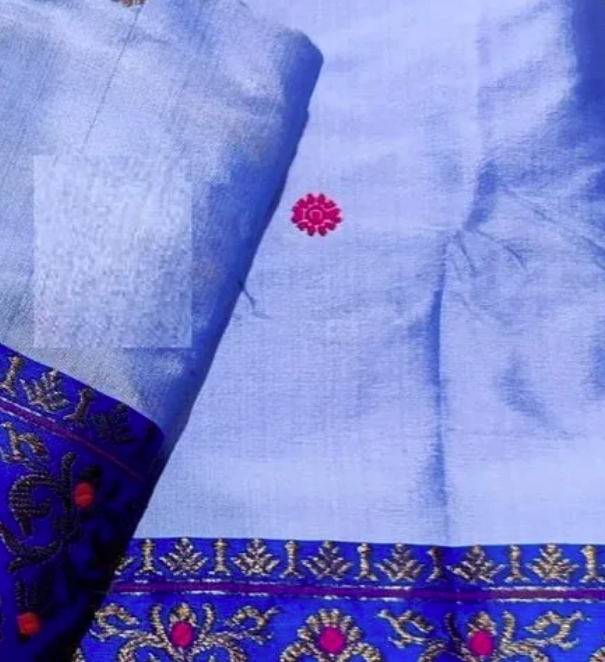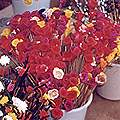The using of natural fibres for making mats, baskets and other products is one of the oldest crafts practised in Pakistan. For centuries artisans have woven, moulded, twisted and stitched a variety of fibres to provide products for numerous purposes.
Rushes and Kana /reed with a core of soft pith grow in abundance along the banks of Pakistan’s rivers and are put to numerous uses. In the past rushes and reeds constituted the principal raw material for constructing village cottages in the plains and in desert regions. Such cottages can still be seen in some areas, and where peasants have built mud brick houses the traditional fodder silo has a roof of twined rushes.
Today however the most common use of rushes is to make prayer mats and runners. The craft is practised by both men and women in many cases as a whole time vocation and by others to fill in the hours between farming chores. The style of weaving is generally very simple. A couple of split rushes are taken and used as a weft to cross the warp threads, first going under a certain number of warps and then going over an equal number. By varying the number of warp threads in the two stages of crossing the artisans weave firm edges. These thick, soft mats can withstand rain and sunshine and are widely used in mosques. They can also serve as a bedding, as a carpet to sit upon, and as a dining mat.
One of the most impressive things made of coiled rushes is the general purpose thick mat. Coiled rushes are wound into modules which are sewn together to form door mats and room mats in different sizes.
The kana is used to create a greater variety of articles. The thicker reed is twined to make moorhas /stools or chairs with backs and arms. The body consists of a double row of twined reeds and the seat and edges are bound with cord. The more affluent often sew leather or deer skin on the sides and edges.
A more common use of thick reeds is in chicks/blinds used for windows and verandahs, which are particularly favoured in summer because of their resistance to heat. A new urban style is to use reed chicks in place of wood panelling in homes and restaurants.
The thinner reeds are used to make baskets for storing grain and dates, chhag/winnowing baskets, boxes for keeping clothes, the gypsy children’s rattle and several other toys.
RAFFIA
Found growing in the wild along river banks is moonj /raffia. The two outer stalks are dried in the sun and are then beaten into thin fibre. The moonj string is useful in scores of ways. The seat of the stool/ moorha and the traditional cot/ charpai is generally made of it. It is also woven into large net-baskets needed to carry goods on animals. Moonj sandals were widely worn earlier and even now they make good slippers for the beach.
HEMP AND JUTE
Ropes and cords are made of date palm, hemp and jute. Village artisans make excellent nets of string to serve as a mouth-lock for animals, and hangers/ chheekas. Earlier chheekas were made only to keep food out of the reach of household pets but now it has become popular with as a hanger for flower pots and decoration plates. Extremely fine cord is used to weave these hangers, which are embellished with beads, frills and pom-poms.
MULBERRY, COTTON PLANT STEMS AND OTHER TREE BRANCHES
Large basket/ tokras made of branches of trees and cotton-plant stem can be seen throughout Pakistan. They are used to carry loads over long distances and by construction workers to carry bricks and sand. At fruit and vegetable shops they are used to keep and display the various commodities.
The most durable baskets are made of mulberry branches these are also used to make the essential structure of the cone-shaped goat-hair baskets used by the Kalash women to carry children and goods on their backs. While thicker branches are woven in a simple style considerable artistic imagination is employed when very thin twigs are woven into small basket. The most intricately designed pieces are the kangris, that are baskets woven around earthen fire-pots which women tuck under their shawls to keep warm. The twigs are often woven into geometric patterns and decorated with beads, tin foil, and frills in different colours.
CANE AND BAMBOO
Cane and bamboo are used to produce a wide range of baskets and other utility objects. Cane is used to make furniture, picnic and flower baskets. The technique is wholly traditional and the cane is heated and moulded into the desired shape and the fixing is done either with cord or with nails. Split cane is used to make plaited mats, baskets and fans. Similarly, split bamboo is used to make a number of items of utility and decoration like sofa sets, tables, chairs, swings, shelves, suit cases, picnic baskets, chicks, flower vases, wall scrolls, etc.
DATE PALM LEAF
The most popular raw material used for crafting mats and baskets is the date-palm leaf and wheat straw. Date-palm is coiled and plaited to make mats and baskets while the common and ubiquitous chatai that is made everywhere and used as walls for huts and for floor covering. Usually the mats are woven in a chequered pattern that is created by using palm leaves that have been dyed pink or black. Split palm leaves are also used to make hand-fans. In the villages of Sindh and Balochistan the fans bear a variety of motifs and are heavily embellished with beads, mirrors, embroidery and frills in different colours. Dera Ghazi Khan is famous for the prayer caps, light, airy and inexpensive, which are used all over the country.
The craft of making coiled palm ropes and then netting them into sacks thrown across the saddles on donkeys and camels is practised in different parts but the craftsmen of Dera Ismail Khan and Peshwar have achieved the highest distinction in this field. Plaited and coiled mazri in Alizai in Kurram Agency are also famous for their intricate designs.
DATE PALM
The date palm is used to make a variety of products including bread baskets. In its simplest form it is changair, a flat plate with slightly raised edges, for serving bread and fruit. More elaborately designed are baskets with lids and used for storing bread, knitting, cloth, etc. Smaller covered baskets that are called dabki in Sindh and chhabi in Punjab display triangular, square and running patterns in different colours. The craftsmen of Uchh Sharif near Bahawalpur and several villages in Multan district are known for their exquisite chhabi designs. In Sindh it is common to decorate dabkis with feathers, cloth frills, and beads, and in the Frontier geometric patterns are created between coloured wrappings with stout threads.
WHEAT GRASS
Wheat straw is used extensively to make large baskets for storing clothes, grain, and dates, changairs, chhabi, baskets and other products. The natural sheen of wheat straw is further accentuated by interweaving different colours into the surface of the products for a greater effect. Dried wheat stems are peeled to obtain the teeli /reed and fibre. The fibre can be plaited like palm-leaf or wrapped around a core of grass to make baskets, table mats, bags and other items. In the Rawalpindi-Murree region, village women produce articles in a wide range using different techniques. Straw is woven into floral designs for ladies bags, purses and table mats. Often cloth, plastic, and foam leather is cut into floral shapes for appliqué work onto the straw articles.
Whatever the material, the most popular form of basketry is the coiled one. The foundation is laid by looping the coil around the central core and building up the spiral, gradually widening the base, until the desired shape and size are reached. The coils are fixed with each other by sewing. In many cases coils are held together by wrapping palm leaves or straw around them. In plaited basketry, two or more sets of warps and wefts are crossed.
Gallery
YOUR VIEWS
PRACTITIONERS: INDIA
Access 70,000+ practitioners in 2500+ crafts across India.
BIBLIOGRAPHY
10,000+ listings on arts, crafts, design, heritage, culture etc.
GLOSSARY
Rich and often unfamiliar vocabulary of crafts and textiles.
SHOP at India InCH
Needs to be written.






